Issue date: June 17, 2019
From Canada Post’s Details magazine: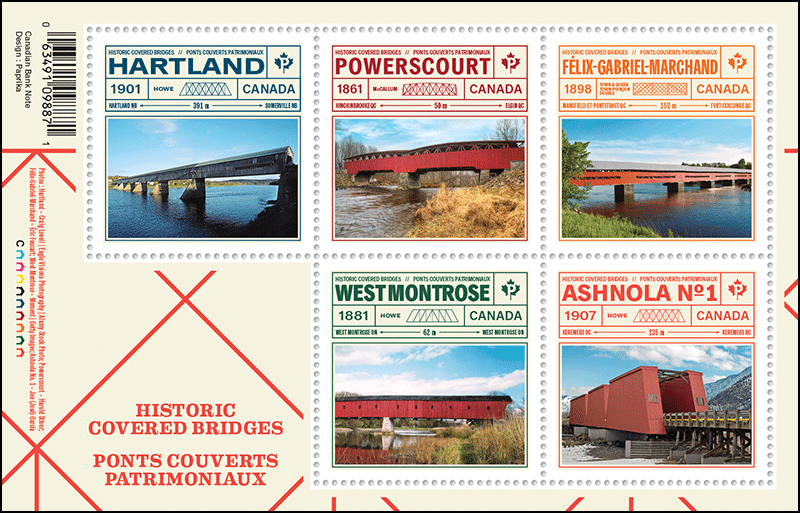 At the end of the 19th century, there were more than 1,400 covered bridges in rural communities across Canada. Today, only an estimated 140 remain.
At the end of the 19th century, there were more than 1,400 covered bridges in rural communities across Canada. Today, only an estimated 140 remain.
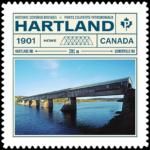 Opened in 1901 and covered in 1922, New Brunswick’s Hartland Bridge is the longest of its kind in the world, spanning 391 metres. An engineering marvel, it boasts seven heavy-timber Howe trusses supported by six piers.
Opened in 1901 and covered in 1922, New Brunswick’s Hartland Bridge is the longest of its kind in the world, spanning 391 metres. An engineering marvel, it boasts seven heavy-timber Howe trusses supported by six piers.
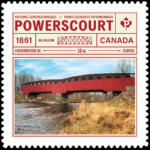 Also known as the Percy Bridge, Quebec’s Powerscourt Bridge, built in 1861, is one of Canada’s oldest covered bridges and the only known example of the McCallum inflexible arched-truss design that is still in existence.
Also known as the Percy Bridge, Quebec’s Powerscourt Bridge, built in 1861, is one of Canada’s oldest covered bridges and the only known example of the McCallum inflexible arched-truss design that is still in existence.
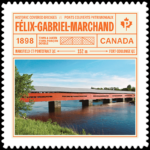 The Félix-Gabriel-Marchand Bridge, extending 152 metres from end to end, is Quebec’s longest covered bridge and one of its oldest. Built in 1898, it is unique in the province for its combination of Queen Post and Town lattice trusses.
The Félix-Gabriel-Marchand Bridge, extending 152 metres from end to end, is Quebec’s longest covered bridge and one of its oldest. Built in 1898, it is unique in the province for its combination of Queen Post and Town lattice trusses.
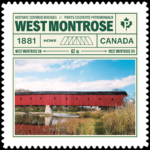 Ontario’s last remaining historic covered bridge, the 60-metre West Montrose Bridge – opened in 1881 over the Grand River – features Howe trusses and louvered window openings.
Ontario’s last remaining historic covered bridge, the 60-metre West Montrose Bridge – opened in 1881 over the Grand River – features Howe trusses and louvered window openings.
The Ashnola No. 1 railroad bridge measuring 135 metres across 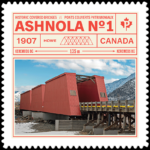 British Columbia’s Similkameen River, was completed in 1907 and rebuilt in 1926 with its Howe trusses sheathed in wood panelling and cross-bracing exposed overhead. It was converted for automobile use in 1961.
British Columbia’s Similkameen River, was completed in 1907 and rebuilt in 1926 with its Howe trusses sheathed in wood panelling and cross-bracing exposed overhead. It was converted for automobile use in 1961. 
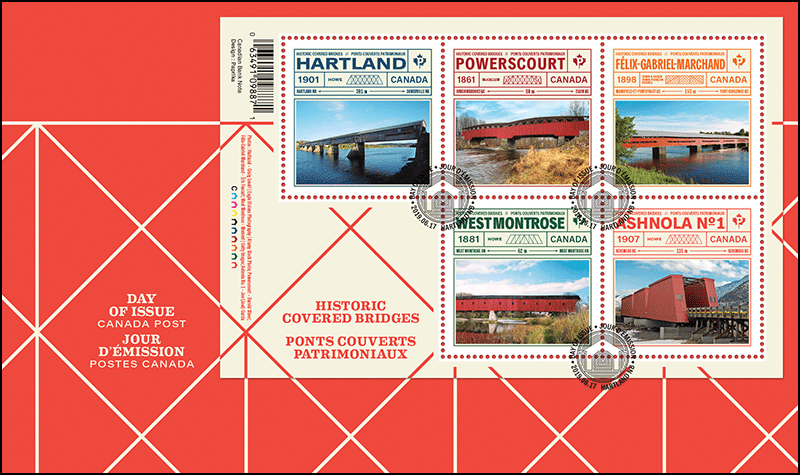
Canada Post’s press release on the day the stamps were released:
[press release]
Quaint but no longer common, covered bridges still dot our countryside – and five historic ones now adorn stamps
 OTTAWA, June 17, 2019 /CNW/ – Built in a bygone era as vital transportation links spanning rivers, covered bridges are now also portals that invite the imagination back to the age of steam locomotives and horse-drawn buggies.
OTTAWA, June 17, 2019 /CNW/ – Built in a bygone era as vital transportation links spanning rivers, covered bridges are now also portals that invite the imagination back to the age of steam locomotives and horse-drawn buggies.
Canada Post today issued five stamps that depict five historic covered bridges across the country. The issue pays tribute to their engineering and design and their role in transportation, but it also recognizes them as important symbols of community life in rural Canada.
At the end of the 19th century, the country had more than 1,400 covered bridges; today, an estimated 140 or so remain. Of the more than 400 covered bridges that once existed in New Brunswick, about 60 still stand – including the longest in the world. Quebec once boasted more than 1,000 but now has about 80. Ontario has only one historic covered bridge, as does British Columbia. Bridges were covered to protect their load-bearing structure from the elements and extend their useful life. These bridges are featured on the stamps:
- Hartland Covered Bridge (New Brunswick)
With a 391-metre span, this bridge across the Saint John River is the longest covered bridge in the world. It was an engineering wonder when it was built at the turn of the 20th century. The original bridge was open; the cover was added in 1922. - Powerscourt (Percy) Bridge (Quebec)
This bridge across the Châteauguay River was built in 1861 and is considered Canada’s oldest covered bridge. With a span of 50 metres, it was built with strong and rigid McCallum inflexible arched trusses. It is the only known bridge left in the world of that McCallum design. - Félix-Gabriel-Marchand Bridge (Quebec)
Known locally as the Marchand Bridge or simply the Red Bridge, this is the longest covered bridge in Quebec, at 152 metres. It crosses the Coulonge River near the village of Fort-Coulonge. Built in 1898, it is one of the oldest surviving covered bridges in Quebec. - West Montrose Covered Bridge (Ontario)
This is Ontario’s last remaining historic covered bridge. It crosses the Grand River in the Waterloo region. It opened in 1881. Often referred to as “the kissing bridge,” the 60-metre bridge is true to its original design, but the concrete and steel parts added later increased its lifespan. Scenes in the 2017 horror movie It, based on a Stephen King novel, were filmed around the bridge. - Ashnola No. 1 Bridge (British Columbia)
Built as a railway bridge over the Similkameen River in 1907, it was first used during the region’s gold mining era. Known locally as the Red Bridge, the 135-metre bridge had its railway tracks removed in 1954 and was opened to vehicles in 1961. It is British Columbia’s only remaining historic covered bridge.
The Official First Day Cover souvenir sheet is cancelled in Hartland, New Brunswick.



